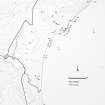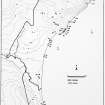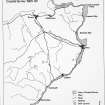Whitegate
Broch (Iron Age)(Possible)
Site Name Whitegate
Classification Broch (Iron Age)(Possible)
Alternative Name(s) White Broch, Wic 099; Keiss North
Canmore ID 9328
Site Number ND36SE 3
NGR ND 3541 6120
Datum OSGB36 - NGR
Permalink http://canmore.org.uk/site/9328
- Council Highland
- Parish Wick
- Former Region Highland
- Former District Caithness
- Former County Caithness
ND36SE 3.00 3541 6120.
(ND 3541 6120) Whitegate Broch (NR)
OS 1:10,000 map, (1973)
Whitegate Broch has an internal diameter of 26ft and a wall thickness of about 13ft. The wall remains to a height of about 3ft.
The slab settings in the central court and the chamber in the wall opposite the entrance are secondary, as also is the series of outbuildings through which the entrance is prolonged.
The finds from the broch include grain-rubbers and rotary querns and fragments of a large jar of coarse, unglazed pottery from one of the internal, secondary structures. This has been reconstructed and is now in the National Museum of Antiquities of Scotland (NMAS), as are the finds from the excavation of the broch by Sir Francis Tress Barry. Anderson notes the remains of the foundations of an oblong, rectangular building within a few yards of the broch. This has been 45ft long by 24ft broad with dry-built walls about 4ft thick. This building seems to compare with the houses of the Viking settlement at Freswick (ND36NE 4), although as Childe points out, these were probably the fore-runners of the 'black-house type', in which case the building might simply be one of these.
Probably similar buildings are also noted at Keiss Broch (ND36SE 20 and the Road Broch (ND36SW 1).
A Young 1964; RCAHMS 1911, visited 1910; Proc Soc Antiq Scot 1893; 1909; J Anderson 1901; V G Childe 1943.
Whitegate Broch is as described above and in a ruinous condition. Resurveyed at 1:2500.
Visited by OS (R D) 14 September 1965.
Internal diameter c.8m, walls c.4m x 1m high. Located on the coastal pasture, 100m N of Keiss broch. Excavated by Tress Barry and now in a ruinous and overgrown condition. WIC 099.
C Batey, Caithness Coastal Survey 1981
Whitegate Broch is as described by the previous authorities; the excavation was never back-filled and the walling is still exposed. The dry-stone structures noted by Batey a short distance to the SW and NE of the broch form no intelligible pattern and their date and purpose remain uncertain.
Visited by OS (N K B) 22 July 1982
ND36SE 3.01 ND 3549 6121 Structure
ND36SE 3.02 ND 3545 6117 Structure
ND 3 6 (area) As part of a wider study of Iron Age Caithness, the broch settlements at Everley (ND 3699 6828), Keiss Harbour (ND 3531 6108), Keiss Road (ND 3488 6151), Whitegate (ND 3541 6120), Skirza (ND 3940 6844), and Hillhead (ND 3762 5140) were recorded by total station survey in June 2000. Aspects of the artefactual assemblage uncovered during 19th-century excavations by Laing and Tress Barry were also studied.
Sponsor: National Museums of Scotland (NMS).
A Heald and A Jackson 2000
ND 3541 6120 As part of a wider study of Iron Age Caithness, four weeks of excavation of the Atlantic roundhouse and outbuilding complex at Whitegate took place in July. The site was first excavated by Sir Francis Tress Barry in 1892-3. He uncovered a number of structural types including a 'broch' or Atlantic roundhouse and numerous outbuildings. Finds were few but included human remains, amber beads and pottery. Recent work on other sites excavated by Tress Barry, particularly Tofts, Everley, has suggested that Barry may have left untouched archaeology on some of the Caithness sites and that reinvestigation was a worthwhile exercise. With this in mind a team from the National Museums of Scotland, AOC Archaeology Group and Nottingham University undertook trial excavations, following on from a programme of survey. Trenches were confined to the roundhouse wall and interior and two of the outbuildings. A laser-scan survey was carried out by Dr Graeme Cavers.
Thanks to the local community for their continuing support, the Caithness Archaeological Trust and Historic Scotland for permission to excavate.
Sponsor: NMS, AOC Archaeology, Nottingham University and Caithness and Sutherland Enterprise.
Andrew Heald, John Barber and Jon Henderson, 2006.
Project (1980 - 1982)
Publication Account (2002)
ND36 5 KEISS NORTH (‘Broch at the White Gate’, ‘Whitegate broch’)
ND/3541 6120 (visited 13/7/63 and in 1971)
This probable solid-based broch in Wick, Caithness, is one of a group of three sited close together near Keiss and which were excavated by Sir F Tress Barry; this one was explored in 1892-93. It is now in ruins and overgrown with turf, standing on flat ground with no sign of outer defences; a mass of ruinous outbuildings surrounds it [9, plan].
Description
The single entrance faces east towards the sea and is 4.12m (13.5ft) long, 76cm (2.5ft) wide at the exterior. It has two door-frames in it, the first being 1.12m (3ft 8in) from the exterior and evidently with only a single rebated door-check in the right wall [5, 156] (though the small plan seems to show another opposite and slightly in front of it. The second door-frame is 1.65m (5.5ft) further in (or 1.77m from the outside) and the checks of this are formed of slabs set into the walls. One of these last is visible on one of Tress Barry's photographs [5, pl. LII). There are no traces of guard cells.
No other intra-mural features were found anywhere except for a break in the inner wallface at about 9 o'clock which may be the entrance to the mural stair; the stair, if it exists, was not uncovered. A secondary cell seems to have been built on the wallhead opposite the entrance and there are two rows of flagstones on edge in the interior, probably also secondary, with a probable hearth (a “cist-like cavity or fireplace some 2.5ft square”) between them; these rows are parallel with the entrance [5, pl. LII]. There are several radial slabs along the 8-10 o'clock arc of the inner wallface, and an aumbry 60cm (2ft) square was found in the inner wallface at about 9 o'clock. No trace of a secondary facing in the court was observed and the fact that the plan of the court is an exact circle (below) tends to confirm that there was no such addition to the primary wall.
Discussion
There is not much that can be said about this probable broch, as the quality of the available information is so poor. One cannot even tell from the available description whether the building had an intra-mural stair; if it did it was either in Level 1 and not uncovered or higher up in Level 2 and no longer extant. Since most of the local brochs have stairs at ground level the former seems probable, but there is no way of knowing if one ever existed. If it did not Keiss North must have been a fairly low structure.
The finds such as they are could indicate a middle Iron Age occupation although the restored pot is of unusual interest and could be earlier [2, fig. 2]. This is a well-known late Bronze Age style known as the Dunagoil vase, being a finer version of the larger and coarser Dunagoil urn. Local examples dated to the end of the Bronze Age were found not many miles away at Crosskirk (ND01 7). Whether this pot, which was clearly in use during the occupation of the broch ('It was found in excavating the interior …. in a multitude of fragments which lay in a group…' [2]), indicates that the site is much earlier than the others nearby, or whether it means that the local ancient pottery style continued in use until the early first millennium AD, is not clear from the evidence available. The latter hypothesis should be preferred unless and until some other local massive roundhouse is clearly dated to the 8th-6th centuries BC.
Finds [2 and 4]
Bone items included 14 pointed and other implements and 1 fragment of a needle.
Stone tools included fragments of rotary querns, several 'grain rubbers' (which could be the mullers of saddle querns), 1 whorl, 4 roughly chipped discs (pot lids?), from 6.5-11cm (2.5-4.5in) in diameter, 1 bead and 1 pebble 5cm (2in) in diameter with a hollow pecked in one face. This last could be a palm protector for use when pushing an awl or needle through tough material (see Dun Ardtreck, NG33 2).
Amber? 1 ring-bead.
Pottery: there were enough potsherds to reconstruct one large vessel of plain, gritty ware with a slightly everted rim having a row of shallow impressions under it [2, fig. 2].
Dimensions: internal diameter 7.93m (26ft), external c. 15.86m (52ft); the wall proportion is therefore 50%. In 1971 a survey of the central court showed that this had been laid out very close to an exact circle with a radius of 3.95 +/- 0.03m (diam. 7.90 m).
Sources: 1. NMRS site no. ND 36 SE 3.00: 2. Proc Soc Antiq Scot 27 (1892-93) 42-44 (pot): 3. Anderson 1901, 127: 4. Proc Soc Antiq Scot 43 (1908-9), 13 (more finds): 5. RCAHMS 1911b, 156-7, no. 516, fig. 40 and pl. 52: 6. Childe 1943, 16: 7. Young 1962, 184: 8. Batey (ms) 1981, nos. 98 and 100 (plan): 9. Swanson (ms) 1985, 586-89 and plan: 10. Baines 1999, 81-2: 11. Heald and Jackson 2001, 129-47.
E W MacKie 2007
Excavation (July 2006)
ND 3541 6120 As part of a wider study of Iron Age Caithness, four weeks of excavation of the Atlantic roundhouse and outbuilding complex at Whitegate took place in July. The site was first excavated by Sir Francis Tress Barry in 1892-3. He uncovered a number of structural types including a 'broch' or Atlantic roundhouse and numerous outbuildings. Finds were few but included human remains, amber beads and pottery. Recent work on other sites excavated by Tress Barry, particularly Tofts, Everley, has suggested that Barry may have left untouched archaeology on some of the Caithness sites and that reinvestigation was a worthwhile exercise. With this in mind a team from the National Museums of Scotland, AOC Archaeology Group and Nottingham University undertook trial excavations, following on from a programme of survey. Trenches were confined to the roundhouse wall and interior and two of the outbuildings. A laser-scan survey was carried out by Dr Graeme Cavers.
Thanks to the local community for their continuing support, the Caithness Archaeological Trust and Historic Scotland for permission to excavate.
Sponsor: NMS, AOC Archaeology, Nottingham University and Caithness and Sutherland Enterprise.
ND 3541 6120 As part of a wider study of Iron Age Caithness, four further weeks (3–31 July 2007) of excavation of the Atlantic roundhouse and outbuilding complex at Whitegate took place. The site was first excavated by Sir Francis Tress Barry in 1892–3. He uncovered a number of structural types including a ‘broch’ or Atlantic roundhouse and numerous outbuildings. Finds were few but included human remains, amber beads and pottery. Parts of the site were re-excavated in 2006 with trenches confined to the roundhouse wall and interior and two of the outbuildings. A laserscan survey was carried out by Dr Graeme Cavers. The 2007 season concentrated on further trenches across the roundhouse wall, parts of the interior, outbuildings and ‘blank areas’ on the mound. Apart from recovering samples and artefacts from the various areas two main findings are of note. First, during excavation across one of the roundhouse walls a chamber was uncovered which contained extensive animal
remains as well as some human remains. These are currently being radiocarbon dated. Second, excavation in the interior recovered a subterranean feature which was accessed by a series of steps. Although not as elaborate as examples from, for example Gurness, Orkney, the Whitegate find is of note. A prosaic explanation as a well may explain this enigmatic structure, but it could equally be associated with ceremonies or rituals. Our thanks are due to the landowners and tenants for their permission to excavate and strong support, and to the Caithness Archaeological Trust and Historic Scotland for further support and advice. Particular thanks to the numerous local individuals and groups who visited and aided with the excavation, particularly those associated with the local primary and secondary schools.
Funder: National Museums of Scotland, AOC Archaeology
Group, Nottingham University and Caithness and Sutherland Enterprise
Andrew Heald, John Barber and Jon Henderson 2006
Excavation (3 July 2007 - 31 July 2007)
ND 3541 6120 As part of a wider study of Iron Age Caithness, four further weeks (3–31 July 2007) of excavation of the Atlantic roundhouse and outbuilding complex at Whitegate took place. The site was first excavated by Sir Francis Tress Barry in 1892–3. He uncovered a number of structural types including a ‘broch’ or Atlantic roundhouse and numerous outbuildings. Finds were few but included human remains, amber beads and pottery. Parts of the site were re-excavated in 2006 with trenches confined to the roundhouse wall and interior and two of the outbuildings. A laserscan survey was carried out by Dr Graeme Cavers. The 2007 season concentrated on further trenches across the roundhouse wall, parts of the interior, outbuildings and ‘blank areas’ on the mound. Apart from recovering samples and artefacts from the various areas two main findings are of note. First, during excavation across one of the roundhouse walls a chamber was uncovered which contained extensive animal
remains as well as some human remains. These are currently being radiocarbon dated. Second, excavation in the interior recovered a subterranean feature which was accessed by a series of steps. Although not as elaborate as examples from, for example Gurness, Orkney, the Whitegate find is of note. A prosaic explanation as a well may explain this enigmatic structure, but it could equally be associated with ceremonies or rituals. Our thanks are due to the landowners and tenants for their permission to excavate and strong support, and to the Caithness Archaeological Trust and Historic Scotland for further support and advice. Particular thanks to the numerous local individuals and groups who visited and aided with the excavation, particularly those associated with the local primary and secondary schools.
Funder: National Museums of Scotland, AOC Archaeology
Group, Nottingham University and Caithness and Sutherland Enterprise
A Heald, J Barber and J Henderson 2007
Excavation (8 July 2008 - 12 July 2008)
ND 3541 6120 A third season of excavation was undertaken, 8–12 July 2008, which concentrated on the exterior area facing the sea. No traces of archaeology were visible prior to the excavation. Excavation revealed a possible enclosure wall, a burial and a drain leading to the roundhouse entrance.
Archive: RCAHMS (intended)
Funder: National Museums Scotland
Andrew Heald, John Barber and Jon Henderson (AOC Archaeology Group), 2008
















































































































